제 3 절. 연구의 한계 및 추후 연구 방향
본 연구는 다음과 같은 몇 가지의 한계점을 갖고 있으며 앞으로의 연구에서는 이들을 추가적으로 고려하는 것이 필요하다 하겠다.
1.본 연구에서는 쌍대질문법만을 이용하여 자료측정을 한 바 있는데 그 결과 많은 항목에서 응답자들이 응답의 어려움을 겪은 것으로 밝혀졌다. 따라서,추후 연구에서는 실험 및 간접질문법과 같은 다른 질문법을 병행하여 연구를 수행하는 것이 바람직하다 하겠다.
2.표본 추출방법으로서 본 연구는 편의표본추출방법을 사용하였기 때문에 표본 추출상의 오류가 발생할 소지가 있었을 뿐만 아니라 또한 분석결과를 일반화하는데 어려움이 있었다.
따라서,후속적인 연구에서는 이러한 점이 특히 고려되어야 할 것이고 아울러. 패스트푸드산업이 비약적인 성장산업이라는 점을 감안할 때 햄버거가 아닌 피자를 포함한 여타 패스트푸드를 대상으로 후속적인 연구가 수행되는 것이 바람직하다 하겠다.
부록/설문지
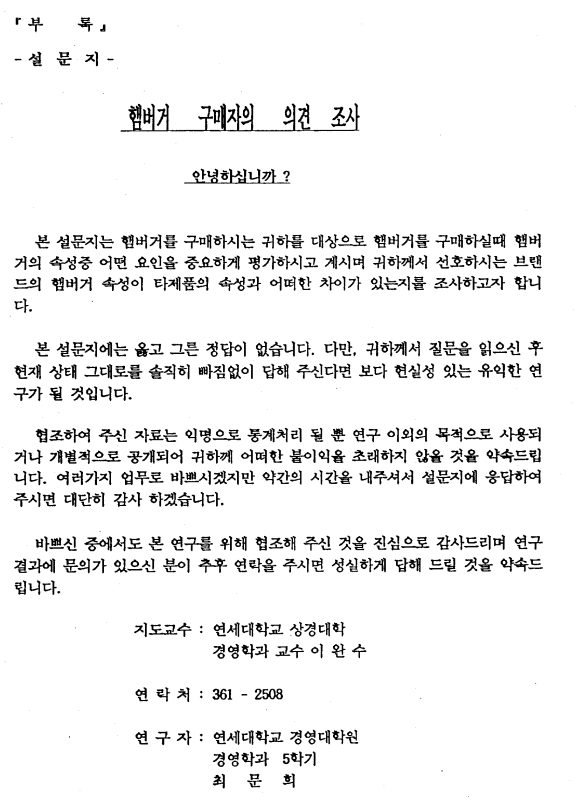
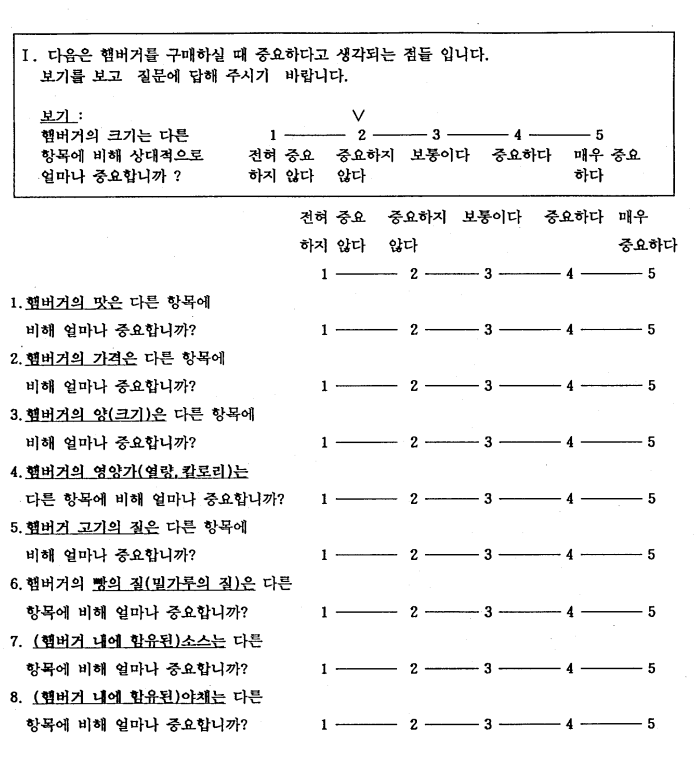
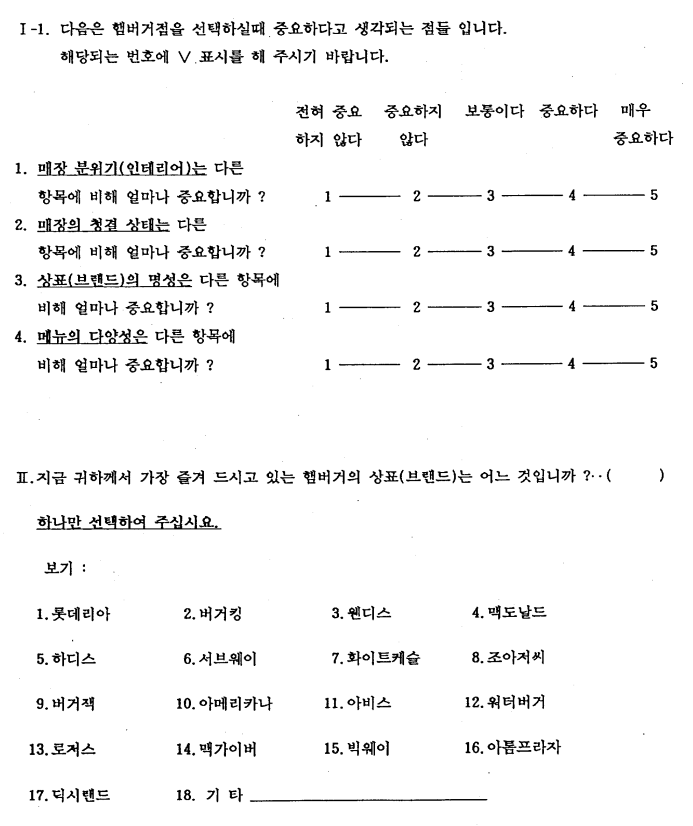
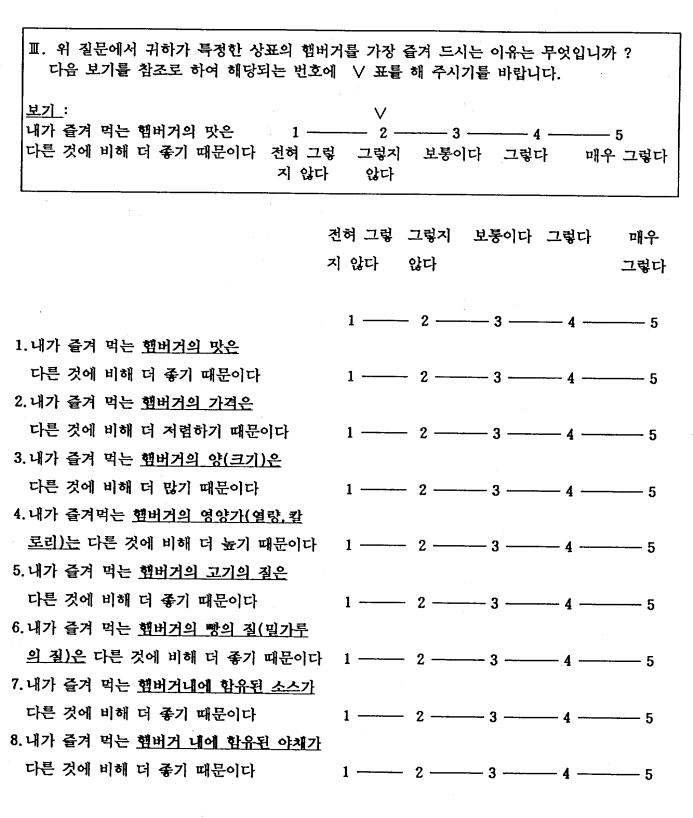
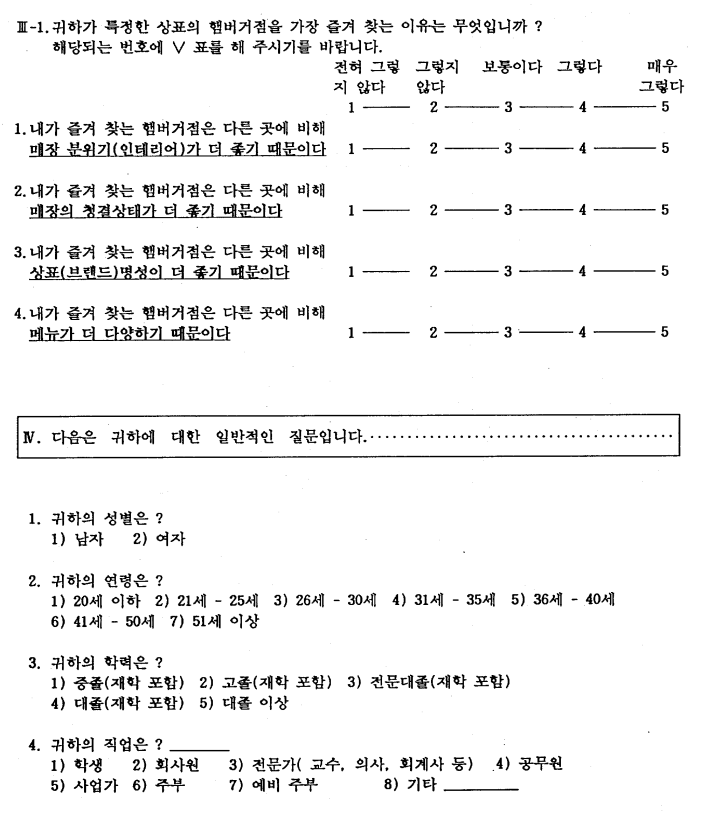
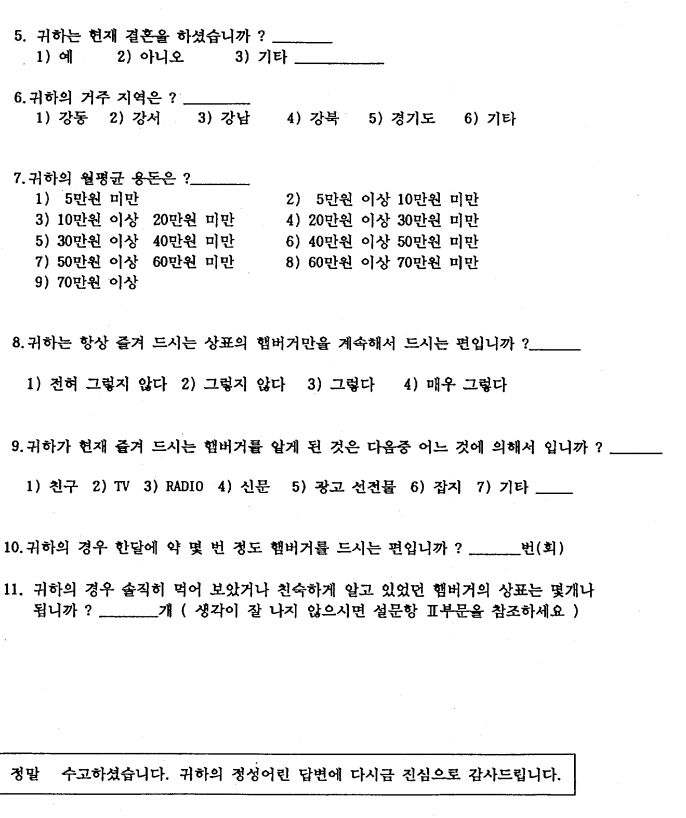
참고문헌
국내문헌
김성균, "서울시 패스트후드 체인점 이용객에 관한 연구", 석사학위 논문, 고려 대학교 대학원, 1986. p. 10.
김지홍, "패스트후드 햄버거점을 중심으로 본 기업 및 상표 이미지 영향요인에 관한 연구", 연세대학교, 경영대학원, 1992
김해식,「 SPSS ┘,박영사,1992.
김충호. "한국 외식산업의 문제와 성장발전", 경기대학 논문집 제 13 집, 1982. 12., pp.447 - 448.
시사여론정보,2월, 1993, 84 - 94면.
월간 경영과 마아케팅. "고속성장을 지속하고 있는 국내 외식시장의 현주소", 1992. 4. pp. 26 - 30,
월간 식당, "성장기를 맞는 햄버거 시장". 1993, 3, pp.76
외국문헌
Alpert M. I. , "Identification of Determinant Attributes : A Comparision of Methods". Journal of Marketing Research, Vol .8,1971. pp.184-191.
Anderson, L. K. , J. R. Taylor and R. J. Halloway, "The Consumer and His Alternative: An Experimental Approach" , Journal of Marketing Research, Vol.3, 1966, p.64.
Bauer, R. A. "Consumer Behavior as Risk Taking", R.S. Hancock(ed.) ,Dynamic Marketing in a Changing World( Chicago : American Marketing Association,1968, pp.369-395.
Banks S., "The Relationship Between Preference and Purchase of Brands", Journal of Marketing, Vol. 15, 1950, pp.145-157.
Boyd H. W. . M. L. Ray and E. Strong, "Attitudinal Framework for Advertising Strategy", Journal of Marketing, Vol 36, 1972. pp.27-33.
Corey L. G. , "How to Isolate Product Attributes", Journal of Advertising Research, Vol. 10, 1970, pp.41-47.
Dichter E., "The Strategy of Desire". New York. Doubleday. 1960.
Reynold F. D. and W. D. Wells, "Consumer Behavior", New York: Mcgraw-Hi11 Inc., 1977, p.225.
Engel.J.F.,and R.D. Blackwell, "Consumer Behavior", 4th ed.,Hinsdale I11- inois: Dryden Press, 1982, p.414.
Fishbein,M. , "attitude, Attitude change and Behavior: A Theoretical Overview", in p. Levine(ed. ), Attitude Research Bridges the Atlantice,1975, pp.3-16.
Gardner,D.M. "Is There a Generalized Price-Quality Relationship?", Journal of Marketing Research, 1971, pp.241-243.
Green p. E. and V. R. Rao, "Conjoint Measurement for Quantifying Judgemental Data", Journal of Marketing Research, Vol . 8, 1971, pp.355-363.
Huber, J, and J. McCann, "The Impact of international Beliefs on Product Evaluation, " Journal of Marketing Research, (August, 1982. pp.324-333.
Kotler,p." Marketing management, " 5th. ed., New Jersey : Prentice-Hall Inc., 1984, pp.28 - 29.
Kretch, D. and Crutchfield, R.S., "Theory and Problems of Social Psychology, " N.Y. :Macgraw-Hill. 1948, 01son, J.C. and R.Kanwar, "Classifying the Confusion Regarding Salience, Importance and Determinance Concept in Multi-Attribute Attitude Research, " in N. Beckwich (ed., ) Educator's Conference Proceeding,1979, PP.286
Abstract
An Empirical Study on the Determinant Attributes of Hamberger in Fastfoods
Choi, Moon Hee Dept. of Marketing The Graduate School of Business Administration Yonsei University
The purpose of this study is to discern the standards of hamburgers that consumers tend to esteem in purchase then define the discerpancy in determinant attributes among the different hamburger brands and demography.
The study found that the two groups that, respectively, preferred Lotteria and McDonald considered the brands' 'taste of hamburgers' commendable while the group that selected Mr. Joe's valued its emphasis on 'vegetables'. Specifically, the Lotteria group appraised Letters hamburger's taste, vegetables, sauce. and quality of meat, while the McDonald group appraised the hamburger's taste, nutritional value, price, and size. The group preferring the Korea-originated Mr. Joe's appreciated the hamburger's vegetables, sauce, dough quality. and taste. (The lists are in order of preference. )
Secondly, according to the analysis of consumer preferences: the taste of McDonald's hamburgers was most popular, then uncle Joe's and finally Lotteria's: the price of Lotteria was most reasonable, followed by McDonald then Mr. Joe's: and the dough quality, sauce, and vegetables of uncle Joe's were most savored followed by the dough quality of Lotteria and the sauce and vegetables of McDonald. Thus, the consumers most highly esteemed the hamburger taste of McDonald, the price of Lotteria, and the dough quality, sauce, and vegetables of uncle Joe's
The study also demonstrated that the male group valued the largeness of hamburgers more than the female group. The emphasis on price was inversely proportional to the consumers' age. Also, the class of undereducated teenagers esteemed the hamburger's price, size, and nutritional value.
Moreover, students considered the hamburger's price and size in purchase more than the working class, and married people thought more of the nutritional value than single people. the inhabitants of the kang-nam area placed more importance on the hamburger's size than the inhabitants of any other areas. And the group with the smaller monthly allowances tended to think more highly of the hamburger's price, size, and nutritional value.
Such results concluded that the group belonging in the age group of students considered the hamburger's price and largeness in purchase, the group of married people emphasized the nutritional value moreso than the group of singles, and men considered the size an important factor more so than the women.
Thus. the three purposes of this study were fulfilled. The results from this study can be incorporated into the marketing strategies of enterprises that have already entered or desire to enter the 'hamburger market'.